人教版的八年级英语下册第三单元教案设计
人教版八年级英语下册Unit3单元教学设计

1.通过情景教学法,创设真实语境,让学生在实际语境中学习并运用一般过去时;
2.运用任务型教学法,设计各种听说读写活动,提高学生的语言综合运用能力;
3.采用小组合作学习,鼓励学生互相交流,分享自己的经历,培养合作精神;
4.利用多媒体教学资源,如图片、视频等,丰富课堂教学内容,提高学生的学习兴趣;
d.课后布置相关作业,让学生运用所学知识进行写作,提高语言运用能力。
2.针对教学难点,采取以下措施:
a.提供典型例句,分析一般过去时的句子结构,帮助学生掌握语法规则;
b.创设丰富的语境,让学生在情境中进行角色扮演,提高口语表达能力;
c.设计分层教学,针对不同水平的学生提供不同难度的练习,使每个学生都能在原有基础上得到提高;
5.通过学习英语,拓宽视野,增强对世界的认知,树立正确的人生观和价值观。
二、学情分析
八年级下册的学生已经具备了一定的英语基础,对一般现在时和一般将来时有了较好的掌握。在此基础上,本单元的一般过去时对于学生来说是一个新的挑战。学生在学习过程中可能存在以下情况:
1.对一般过去时的理解和运用尚不熟练,需要通过具体实例和反复练习来巩固;
2.学会使用一般过去时描述过去发生的事情,如:I visited my grandparents last week;
3.能够听懂并参与课堂讨论,分享自己的过去经历;
4.提高阅读理解能力,理解并掌握课文中的重点句型和语法结构;
5.提高写作能力,能够运用一般过去时写作文,描述过去发生的事情。
(二)过程与方法
4.教师带领学生进行句型替换练习,巩固一般过去时的用法。
(三)学生小组讨论
1.教师将学生分成小组,要求他们用一般过去时描述过去发生的事情,如:“What did you do last weekend?”
人教版八年级英语下册教案:Unit3SectionB(2a2e)教学设计

(四)课堂练习
1.教师设计一系列关于一般过去时的练习题,包括填空、选择、改错等,让学生独立完成,巩固所学知识。
2.学生互相交换练习本,进行批改和讨论,培养学生互帮互助、共同进步的良好氛围。
3.教师针对学生练习中出现的共性问题进行讲解,帮助学生突破难点。
八年级下册的学生经过前期的英语学习,已经具备了一定的英语基础,包括词汇、语法和听说能力。在此基础上,他们对本节课的话题“过去的活动”有一定的认知,能够运用一般过去时描述过去发生的事情。然而,学生在实际运用中,对一般过去时的动词变化和句型结构掌握不够熟练,需要教师在教学中进行针对性的指导。
此外,学生在学习过程中,对英语学习的兴趣和动机存在差异。部分学生对英语学习表现出较高的热情和自信,积极参与课堂活动;而另一部分学生则相对被动,缺乏自信,课堂参与度较低。因此,教师在教学过程中应关注学生的情感态度,通过多样化的教学活动,激发学生的学习兴趣,增强学生的学习自信心。
3.通过小组合作,让学生完成2b的练习,互相检查动词过去式的使用,提高学生的合作能力和语言实践能力。
4.教师针对学生的完成情况进行点评,纠正错误,强化正确用法。
(三)学生小组讨论
1.教师将学生分成小组,要求每组讨论并分享组员们过去做过的有趣活动,用一般过去时进行描述。
2.每个小组选取一个代表进行汇报,其他组员补充,培养学生团队合作和口语表达能力。
3.引导学生关注动词的过去式变化,为学生讲解一般过去时的基本概念和用法,为新课的学习做好铺垫。
(二)讲授新知
1.教师呈现Unit 3 Section B 2a的听力材料,引导学生边听边关注动词的过去式形式,让学生在语境中感知和学习一般过去时。
(完整版)英语人教版八年级下册Unit3教学设计

(完整版)英语人教版八年级下册Unit3教学设计课题:Unit 3 Could you please clean your room?Period 1 (Section A 1a-1c)学习目标【Learning objectives】1.掌握单词: rubbish, fold, sweep, floor, take out the rubbish.2.学会礼貌地提出请求并熟练练习对话。
重点和难点【Important and difficult points】教学重点:能熟练拼读单词及短语rubbish, fold, sweep, floor, take out the rubbish.教学难点:学会用句型“Could you please…”来礼貌地提出请求。
预习内容【prepare lessons before class】1.要求学生掌握单词rubbish, fold, sweep, floor, take out the rubbish并指导学生找出家务活的表达方式。
2. 指导学生用“Could you please…”造句。
学习过程【Learning process】一、预习反馈,明确目标【Preview feedback, Clear objective】1.本节课的单词你有更多的是积累吗?2.写出更多家务琐事的表达方式:3.你知道怎样礼貌地提出请求吗?二、创设情境,自主探究【Create situations, Self inquiry】1. T: 1) Do you help to do any chores at home ?2) What work do you usually do to help your parents?3) Which one are you good at?Ss: Discuss the teacher’s questions with their partners.2. Check(√) the chores you can do in 1a and add more chores.三、展示交流,点拨提升【Display communication, Coaching to enhance】1. T: 1. Who are the two people in the picture? Why do yousay so?2. Where are they? How do you know?2. Read the chores and add more chores.3. Use “Could you please…” to make a conversation just like Peter and his mother. 1c.4. Listen to 1b and check their answers.四、师生互动,拓展延伸【Teacher-student interaction, Development】【归纳】Make polite requests. ------ Could you please…? Yes, sure./ OK, but……【拓展】1.Can you do some dishes?2. rubbish的同义词:eg. You do talk rubbish sometimes. 胡言乱语【辨析】1. do 与make2. clean 与sweepeg. Let’s clean the house. You sweep the floor and I wash the dishes.五、达标测评, 巩固提高【Evaluation standards,Consolidation and improvement】基础题I. 根据句意及首字母提示写出单词。
人教新目标八年级英语下册第3单元教学设计(教案)
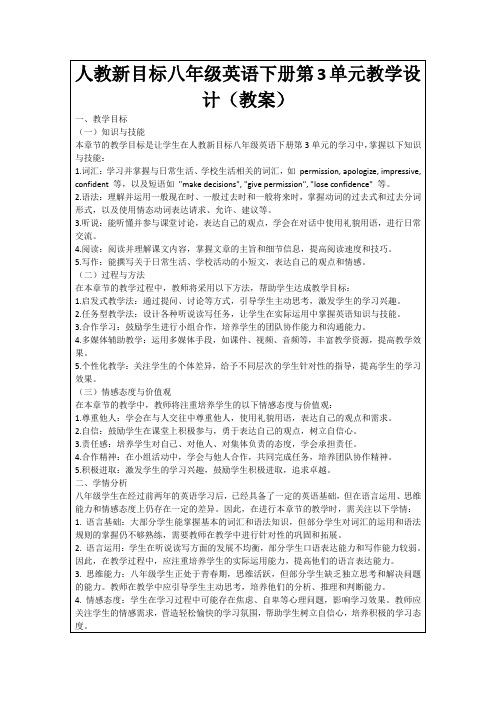
-引导学生通过预测、提问、总结等策略,提高阅读理解的深度和广度。
(二)教学设想
1.情境教学法:将学生带入真实的语言环境,让他们在情境中感知、体验和运用语言。
-设想实践:利用多媒体资源,如视频、音频,创建生动的情境,让学生在情境中学习。
2.互动式教学:鼓励学生参与课堂讨论,促进学生之间的互动,提高课堂活跃度。
人教新目标八年级英语下册第3单元教)知识与技能
本章节的教学目标是让学生在人教新目标八年级英语下册第3单元的学习中,掌握以下知识与技能:
1.词汇:学习并掌握与日常生活、学校生活相关的词汇,如permission, apologize, impressive, confident等,以及短语如"make decisions", "give permission", "lose confidence"等。
2.听说能力:提高学生的听说能力,尤其是日常交流中的礼貌用语和表达请求、允许的能力,是本章节的另一个重点和难点。
-教学设想:利用角色扮演、小组讨论等形式,模拟真实场景,让学生在互动中练习听说技巧。
-定期举办英语角活动,鼓励学生大胆开口,提高口语表达能力。
3.阅读理解:培养学生快速捕捉文章主旨和细节信息的能力,是阅读教学的重点。
在本环节中,教师将通过以下步骤引导学生进入新课的学习:
1.利用多媒体展示与新课主题相关的图片或视频,激发学生的兴趣和好奇心。
-例如,展示一些学生在学校参加活动的照片,引导学生关注学校生活中的规则和礼貌。
2.提出问题,引导学生思考与新课内容相关的话题。
-如:“Can you tell me what you need to do before you take part in a school activity?”
人教版英语八年级下册Unit3SectionB教学设计

5.培养学生的写作能力,能够仿照课文写出关于志愿者活动的短文。
(二)过程与方法
在本章节的学习过程中,教师将采用以下方法引导学生学习:
1.采用任务型教学法,通过设置真实语境,让学生在完成任务的过程中,运用所学知识和技能。
(三)情感态度与价值观
在本章节的学习中,学生将培养以下情感态度与价值观:
1.培养学生的社会责任感,使他们认识到参与志愿者活动的重要性,学会关爱他人,回馈社会。
2.培养学生积极向上的生活态度,鼓励他们积极参与社会活动,丰富自己的人生经历。
3.增强学生的团队协作意识,使他们懂得在集体中互相帮助、共同进步的重要性。
4.教学策略:
(1)针对学生的个体差异,实施分层教学,提高教学效果。
(2)注重情感教育,关注学生的心理健康,营造良好的学习氛围。
(3)鼓励学生积极参与课堂活动,提高学生的自信心和自主学习能力。
(4)定期进行教学反思,调整教学方法和策略,不断提高教学质量。
四、教学内容与过程
(一)导入新课
1.教学活动设计:
2.运用合作学习法,鼓励学生进行小组讨论、交流,培养学生的团队协作能力和口语表达能力。
3.引导学生通过自主阅读、思考、总结,提高学生的阅读理解能力和自主学习能力。
4.利用多媒体教学资源,如图片、视频等,丰富课堂教学,提高学生的学习兴趣。
5.通过课后作业和实践活动,巩固所学知识,提高学生的实际运用能力。
-培养学生的自主学习能力和反思能力。
-激发学生学习英语的兴趣和信心,为下一节课的学习做好准备。
五、作业布置
针对本节课的学习内容,特布置以下作业,以巩固所学知识,提高学生的实际运用能力:
及分析人教版英语八年级下册Unit3大单元教学设计

-定期组织展示活动,让学生在实践中展示自己的学习成果,增强自信心。
4.教学延伸:
-鼓励学生参与学校或社区的实际志愿者活动,将所学知识运用到实践中。
-建立学习小组,利用课后时间进行英语角活动,提高学生的语言实际运用能力。
-结合单元主题,开展跨学科活动,如社会调查、研究报告等,拓宽学生的学习视野。
4.口语作业:与家人或朋友进行一次关于志愿者工作的英语对话,尝试使用本节课学到的词汇和时态,记录下对话内容。
5.研究任务:选择一个感兴趣的志愿者组织或活动,通过网络或图书馆资源,了解该组织或活动的基本信息、活动宗旨和参与方式,下节课向同学分享。
作业布置注意事项:
-确保作业难度适中,既能巩固课堂所学,又不会给学生造成过重的负担。
四、教学内容与过程
(一)导入新课
在这一阶段,教师将运用多媒体资源,以生动有趣的方式导入新课。首先,在大屏幕上展示一组志愿者活动的图片,如环保清洁、帮助老人过马路等,让学生们观察并思考这些图片中的共同点。随后,提出问题:“What are they doing? Why do they do these things?”引导学生展开思考。
(二)过程与方法
在本章节的教学过程中,教师将采用以下方法帮助学生达成学习目标:
1.采用任务型教学法,引导学生通过完成具体的任务,如小组讨论、角色扮演等,提高英语实际运用能力。
2.利用多媒体教学资源,如图片、视频等,激发学生的学习兴趣,增强课堂的趣味性。
3.通过小组合作学习,培养学生的团队协作能力和沟通能力。
-通过真实语境的创设,让学生在实践中感受时态的用法,提高口语表达能力。
-引导学生通过预读、细读和总结等步骤,提高阅读理解能力。
人教版八年级英语下册第三单元(同步教学设计)

3.教师针对练习中出现的问题,进行集中讲解,帮助学生纠正错误。
4.学生互相批改练习,提高他们的自主学习能力。
5.教师对学生的练习成果进行评价,鼓励优秀学生,对学困生给予关心和指导。
(五)总结归纳,500字
1.教师引导学生回顾本节课所学内容,总结词汇、短语、句型和阅读策略。
d.课堂活动:组织小组讨论、角色扮演、采访等,让学生在实际运用中提高语言能力。
e.课后作业:布置分层作业,针对不同层次的学生制定不同难度的任务,提高作业的针对性和实效性。
3.教学评价:
a.形成性评价:关注学生在课堂活动中的表现,给予及时的反馈和鼓励。
b.终结性评价:通过单元测试、期中考试等方式,全面评估学生的学习成果。
3.学生分享自己的预测结果,教师总结并引出本单元的主题——“成功之路”。
4.教师展示与本单元相关的图片或视频,引导学生观察并思考:“How can we achieve success? What efforts do we need to make?”
5.学生就观察到的内容进行小组讨论,为接下来的新课学习做好铺垫。
人教版八年级英语下册第三单元(同步教学设计)
一、教学目标
(一)知识与技能
本章节旨在帮助学生掌握人教版八年级英语下册第三单元的核心词汇、短语和句型,培养他们运用英语进行日常交流的能力。具体包括:
1.掌握本单元的生词和短语,如:interview, achievement, improve, participate, contribute, success, effort, confident等,并能在实际语境中正确运用。
二、学情分析
八年级学生经过前两年的英语学习,已具备一定的英语基础,但在语言实际运用、阅读理解及写作方面仍有待提高。因此,在进行本章节教学时,需关注以下几点:
英语人教版八年级下册Unit 3 教学设计
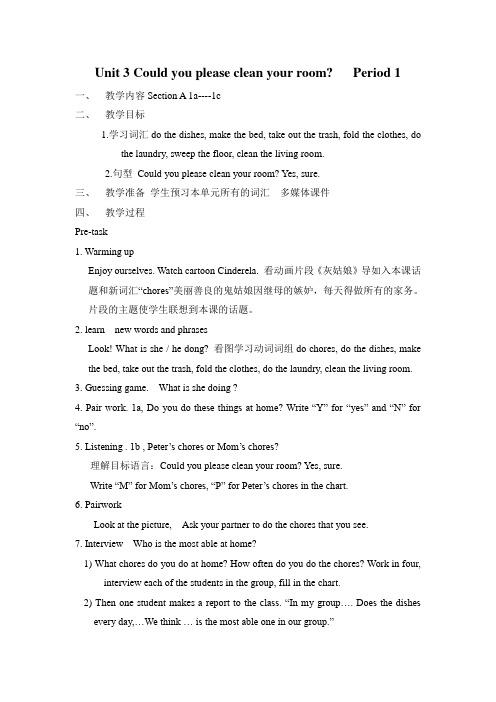
Unit 3 Could you please clean your room? Period 1一、教学内容Section A 1a----1c二、教学目标1.学习词汇do the dishes, make the bed, take out the trash, fold the clothes, dothe laundry, sweep the floor, clean the living room.2.句型Could you please clean your room? Yes, sure.三、教学准备学生预习本单元所有的词汇多媒体课件四、教学过程Pre-task1. Warming upEnjoy ourselves. Watch cartoon Cinderela. 看动画片段《灰姑娘》导如入本课话题和新词汇“chores”美丽善良的鬼姑娘因继母的嫉妒,每天得做所有的家务。
片段的主题使学生联想到本课的话题。
2. learn new words and phrasesLook! What is she / he dong? 看图学习动词词组do chores, do the dishes, make the bed, take out the trash, fold the clothes, do the laundry, clean the living room.3. Guessing game. What is she doing ?4. Pair work. 1a, Do you do these things at home? Write “Y” for “yes” and “N” for “no”.5. Listening . 1b , Peter’s chores or Mom’s chores?理解目标语言:Could you please clean your room? Yes, sure.Write “M” for Mom’s chores, “P” for Peter’s chores in the chart.6. PairworkLook at the picture, Ask your partner to do the chores that you see.7. Interview Who is the most able at home?1) What chores do you do at home? How often do you do the chores? Work in four,interview each of the students in the group, fill in the chart.2) Then one student makes a report to the class. “In my group…. Does the dishesevery day,…We think … is the most able one in our group.”8. 总结本节课的教学重点。
人教版八年级英语下册Unit3SectionA1a~2d教学设计
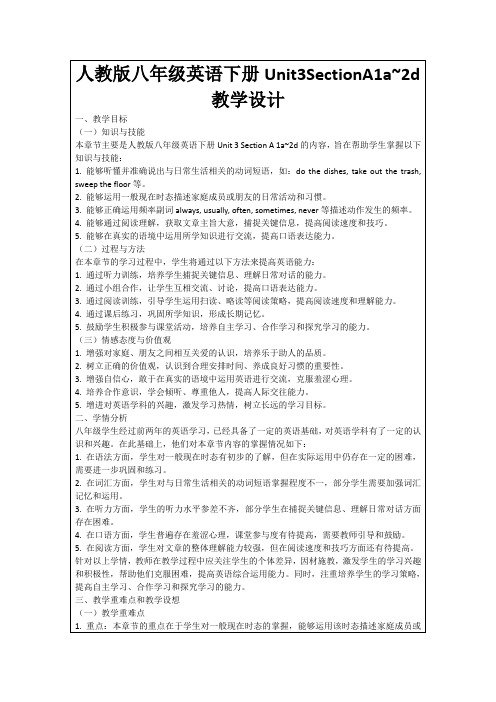
(二)教学设想
1.针对一般现在时态的教学,我将采用以下策略:
a.通过生动的情景剧或动画,让学生在具体的语境中感知一般现在时态的使用,增强记忆。
b.设计互动性强的课堂活动,如角色扮演、口头报告等,让学生在练习中巩固时态运用。
c.创造语境,引导学生用一般现在时态描述自己的生活,提高语言实际运用能力。
针对以上学情,教师在教学过程中应关注学生的个体差异,因材施教,激发学生的学习兴趣和积极性,帮助他们克服困难,提高英语综合运用能力。同时,注重培养学生的学习策略,提高自主学习、合作学习和探究学习的能力。
三、教学重难点和教学设想
(一)教学重难点
1.重点:本章节的重点在于学生对一般现在时态的掌握,能够运用该时态描述家庭成员或朋友的日常活动和习惯,以及正确使用频率副词。
5.增进对英语学科的兴趣,激发学习热情,树立长远的学习目标。
二、学情分析
八年级学生经过前两年的英语学习,已经具备了一定的英语基础,对英语学科有了一定的认识和兴趣。在此基础上,他们对本章节内容的掌握情况如下:
1.在语法方面,学生对一般现在时态有初步的了解,但在实际运用中仍存在一定的困难,需要进一步巩固和练习。
5.鼓励学生积极参与课堂活动,培养自主学习、合作学习和探究学习的能力。
(三)情感态度与价值观
1.增强对家庭、朋友之间相互关爱的认识,培养乐于助人的品质。
2.树立正确的价值观,认识到合理安排时间、养成良好习惯的重要性。
3.增强自信心,敢于在真实的语境中运用英语进行交流,克服羞涩心理。
4.培养合作意识,学会倾听、尊重他人,提高人际交往能力。
四、教学内容与过程
(一)导入新课
八年级英语下册(人教版)Unit3单元整体教学设计

学生分组进行角色扮演,模拟旅游场景,录制一段对话视频。要求对话内容涉及以下方面:
-询问和回答关于旅游景点的问题;
-描述景点的历史、文化及特色;
-推荐旅游路线和活动。
3.阅读作业:
阅读一篇关于旅游的英文文章,完成文章后的阅读理解练习。要求学生在阅读过程中,关注文章中的关键信息,提高阅读理解能力。
4.通过学习本单元,使学生认识到旅游不仅是休闲娱乐,还是了解世界、增长知识、陶冶情操的途径。
在教学过程中,教师要关注学生的学习需求,尊重学生的个性差异,创设有趣、有挑战性的教学活动,激发学生的学习兴趣和积极性。同时,注重培养学生的语言运用能力、思维品质、文化意识和学习能力,使学生在学习英语的过程中,实现全面发展。以下是对本单元的整体教学设计:
(2)运用一般现在时和一般过去时描述城市或景点的特点、历史、文化等。
(3)提高学生的听说能力,使其能在实际场景中运用所学知识进行交流。
2.难点:
(1)正确运用一般过去时描述景点的历史、文化等。
(2)在实际场景中,运用所学词汇和句型进行流畅的表达。
(3)提高学生的信息获取能力,能够从地图、旅游手册等非文字材料中获取关键信息。
(四)课堂练习,500字
1.听力练习:教师播放一段关于旅游的听力材料,学生需完成相应的练习题,检测听力理解能力。
2.口语练习:学生进行角色扮演,模拟导游与游客的对话,实际运用所学词汇和句型。
3.阅读理解:学生阅读课文,了解不同城市的特点,完成相应的阅读理解题目。
4.写作训练:要求学生运用所学词汇和句型,编写一篇关于自己家乡或旅游目的地的短文。
8.多元评价,促进全面发展:
采用形成性评价和终结性评价相结合的方式,关注学生的学习过程和结果,给予及时反馈,促进学生听说读写能力的全面发展。
最新人教版八年级英语下册Unit3单元教案

最新人教版八年级英语下册Unit3单元教案人教版初中英语八年级下册Unit 3 Could you please clean your room?Section A 第一课时I. Teaching contentSection A 1a-1c, 2a-2bII. Teaching aims1. Make polite requests. 学会有礼貌地提出请求。
2. Ask for permission. 对别人的请求做出回答。
III. Important points1. 掌握以下句式: Could you please sweep the floor?Yes, sure. Can you do the dishes?2.掌握以下词汇: do the dishes, take out the rubbish, fold your clothes, sweep the floor, make your bed, clean the living room, go out for dinner, stay out late, get a ride, work on IV. Difficult points:1.学会有礼貌地提出请求。
2. 对别人的请求做出回答。
V. Teaching steps(教学步骤)1. Warm-up and revision(课堂热身和复习)复习第一与第二单元的内容T: _______ isn’t here. What’s the matter with her?S: She has a bad cold/headache…T: Can you help her take down some notes?S: …(老师可以鼓励学生给出尽可能多的答案)T: Oh, I’m glad that you are very helpful. You are an example to other students.2. Presentation(呈现新知识)T: What do you usually do on weekends except playing computer games? Do you often help your parents do some chores?S1: …T: Oh, you often do chores on weekends. What chores do you do on weekends? (教师在重复时应用夸张的语调来强调chores这一单词,并把chores写到黑板上,然后用图片帮助同学回答出 ) S2: … do the dishes… take out the rubbish… fold the clothes… sweep th e floor… make the bed… clean the living room3. Work on 1a1)T: Do you do these chores at home? Discuss them with your partner.1. do the dishes2. take out the rubbish3. fold your clothes4. sweep the floor5. make your bed6. clean the living room(让学生讲他们在家做的家务情况,听他们讲英语的情况)2)T: Look at the picture in 1a. Peter and his mother are talking at home. Peter’s mother wants his son to take out the rubbish. Please look at the dialogue. And read it out with your partner.S1: Peter, could you please take out the rubbish?S2: Sure, Mom.(教师可以四处走动,以帮助学生改正错误,特别是take outthe rubbish 这一词组)3)T: What will your mother say if she wants you to do the chores? (用图片进行教学)T: Could you please make the bed?S1: Yes, sure.(Continue with the rest of the pictures.)4. Work on 1b1)T: Now you’ll hear a conversation. Who will do these chores? Check Peter’s mother or Peter.(教师放录音,因为对话简单教师可以在放完一遍录音以后就订正答案)T: Listen again and try to remember the dialogue. And fill in the blanks. (教师投影这页幻灯片。
八年级英语下Unit 3 教案人教版
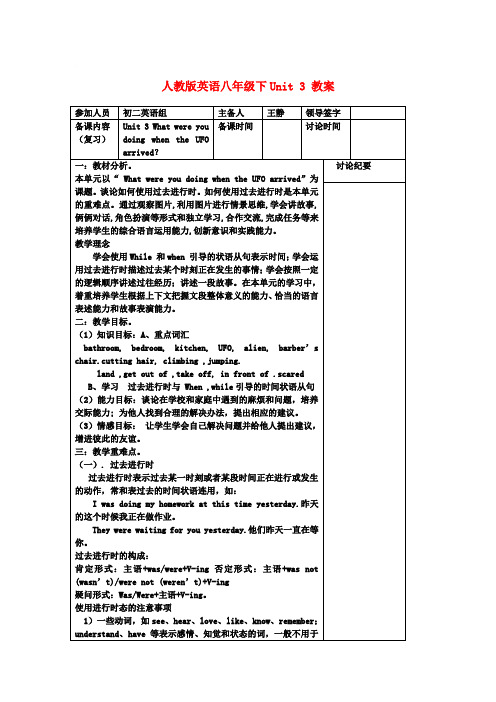
人教版英语八年级下Unit 3 教案参加人员初二英语组主备人王静领导签字备课内容(复习)Unit 3 What were youdoing when the UFOarrived?备课时间讨论时间一:教材分析。
本单元以“ What were you doing when the UFO arrived”为课题。
谈论如何使用过去进行时。
如何使用过去进行时是本单元的重难点。
通过观察图片,利用图片进行情景思维,学会讲故事,俩俩对话,角色扮演等形式和独立学习,合作交流,完成任务等来培养学生的综合语言运用能力,创新意识和实践能力。
教学理念学会使用While 和when 引导的状语从句表示时间;学会运用过去进行时描述过去某个时刻正在发生的事情;学会按照一定的逻辑顺序讲述过往经历;讲述一段故事。
在本单元的学习中,着重培养学生根据上下文把握文段整体意义的能力、恰当的语言表述能力和故事表演能力。
二:教学目标。
(1)知识目标:A、重点词汇bathroom, bedroom, kitchen, UFO, alien, barber’schair.cutting hair, climbing ,jumping.land ,get out of ,take off, in front of .scaredB、学习过去进行时与 When ,while引导的时间状语从句(2)能力目标:谈论在学校和家庭中遇到的麻烦和问题,培养交际能力; 为他人找到合理的解决办法,提出相应的建议。
(3)情感目标:让学生学会自己解决问题并给他人提出建议,增进彼此的友谊。
三:教学重难点。
(一). 过去进行时过去进行时表示过去某一时刻或者某段时间正在进行或发生的动作,常和表过去的时间状语连用,如:I was doing my homework at this time yesterday.昨天的这个时候我正在做作业。
They were waiting for you yesterday.他们昨天一直在等你。
人教版八年级英语下册Unit3教学设计

3.学生在课堂上表现积极,乐于参与各种活动,但部分学生过于依赖教师引导,缺乏自主学习能力,需要在教学中逐步培养。
4.学生在情感态度上,对英语学习兴趣较浓,但在面对困难时,容易产生挫败感,需要教师关注学生的心理变化,适时给予鼓励和支持。
3.句型:学生能够掌握以下句型的用法:What did you do last weekend? I went to the beach. How was your day? It was boring. What did you have for lunch? I had a delicious sandwich等。
3.学会与他人分享快乐,提高团队协作能力。
4.增强自信心,勇于尝试新事物,不断挑战自我。
5.感受英语学习的乐趣,树立学习英语的信心,提高自主学习能力。
二、学情分析
针对人教版八年级英语下册Unit3的教学内容,对学生学情进行分析如下:
1.学生已具备一定的英语基础知识,能够运用简单的英语进行日常交流,但在表达过去事情时,对动词过去式的运用尚不熟练,需要进一步巩固和指导。
四、教学内容与过程
(一)导入新课
1.教师通过展示一组图片,如:孩子们在沙滩玩耍、参观博物馆、野餐等,引导学生观察并询问:“What are they doing?”、“Can you guess what they did last weekend?”,从而引出一般过去时态的概念。
2.邀请学生分享他们上周的有趣经历,让学生尝试用英语描述,为新课的学习营造轻松愉快的氛围。
5.自主学习:
a.利用网络资源,查找一般过去时的相关资料,加深对语法知识点的理解。
Unit3教学设计人教版八年级英语下册

人教版八年级英语下册第三单元同步教学设计Unit 3Could you please clean your room?1.本单元话题以“家庭琐事与许可”展开,情境属于2022新课标“人与自我”主题范畴中的“做人与做事”这一主题群,涉及子主题“劳动实践,劳动品质与工匠精神”和“勤于动手,乐于实践,敢于创新”。
2.单元主题体现《中国学生发展核心素养》中的“社会参与”方面,提升学生的“实践创新”这一素养,立足于“劳动意识”这一基本要点。
3.能听懂有关做家务,与家人相处或者提建议的对话,并能利用情态动词could来礼貌地提出要求或者征询许可。
4.能读懂关于做家务、帮助他人的文章,并在生活中践行乐于助人的品质。
5.能够围绕“帮助他人”这一话题来进行写作,并维持良好的生活习惯。
6.培养学生家庭责任和义务的意识,增强主动做家务的自觉性。
续表【课时建议】本单元建议5课时Section A (1a-2d)(一课时)Section A (3a-3c)(一课时)Section A (Grammar Focus-4c)(一课时)Section B (1a-1e)(一课时)Section B (2a-Self Check)(一课时)词汇短语:主要采用图片及多媒体展示助记法。
基本句子:采用多媒体展示及交际法(利用多媒体展示两人进行交际时的情景)。
语法:通过对话练习让学生学习情态动词could的用法。
第一课时Section A (1a-2d)Step 1情景导入T:Do you often do housework at home?Take out the rubbish,make the bed or sweep the floor?Doing these things is an exercise and a good way of helping parents.And when talking to parents,it's important to be polite.“Could you please…?” and “Could I…?” are useful sentences to make requests and ask for permission politely.S:…设计意图:通过谈话的方式导入本单元重点句型,激发学生学习本单元的兴趣。
人教版英语八年级下册Unit3sectionB(2a2e)教学设计

人教版英语八年级下册Unit3sectionB(2a2e)教学设计
一、教学目标
(一)知识与技能
1.学生能够掌握并运用本节课的重点词汇和短语,如"volunteer", "donate", "raise money", "help sb. with sth."等,并能运用这些词汇描述和讨论社会公益活动。
3.口语作业:学生分小组,选择一个社会公益活动主题,进行角色扮演,录制一段对话视频。要求每位成员都参与其中,充分展示所学词汇和语法。
4. �搜索实践:鼓励学生利用网络资源,了解国内外社会公益活动的现状,选择一个感兴趣的活动,整理相关资料,为下节课的课堂展示做好准备。
5.情感反思:请学生反思自己在参与社会公益活动过程中的表现,思考如何在日常生活中继续发扬公益精神,为他人提供帮助。以书面形式记录自己的思考,与同学分享。
二、学情分析
八年级学生经过前一阶段的学习,已具备一定的英语基础,对英语学习有较高的兴趣。在此基础上,他们对本节课所涉及的公益活动主题已有初步的了解和认识,但对社会公益活动的具体形式和实施方法可能仍存在一定的陌生感。因此,在教学过程中,教师应充分考虑学生的认知水平,通过生动有趣的教学活动,激发学生的学习兴趣,提高他们的学习积极性。
2.互动教学:采用任务型教学法,设计小组讨论、角色扮演等互动环节,让学生在实际语境中运用所学词汇和语法,提高他们的语言实践能力。
3.阅读策略训练:引导学生运用略读、寻读和精读等策略,对文章进行深入分析,培养学生的阅读理解能力和批判性思维。
4.情感教育:结合教学内容,适时引入真实的社会公益活动案例,让学生感受到参与公益的意义,从而培养他们的社会责任感和同理心。
人教版八年级英语下册Unit3单元整体教学设计

针对以上学情,教师在教学过程中应关注以下几点:
1.针对不同学生的语言能力,设计难易适度的教学活动,使每个学生都能在原有基础上得到提高。
2.加强对过去时态的讲解和练习,通过情境创设、角色扮演等方式,帮助学生熟练掌握并运用过去时态。
2.口语作业:学生与家长或朋友一起,用一般过去时态进行对话练习,分享彼此的过去经历。家长或朋友可协助记录对话内容,以供课堂上展示和讨论。
3.词汇积累:要求学生整理本单元所学的动词短语和一般过去时态的动词变化,制作成词汇卡片,便于随时复习和巩固。
4.阅读作业:推荐学生阅读一篇关于过去经历的英文文章或故事,并完成相关阅读理解练习。旨在提高学生的阅读能力,同时巩固一般过去时态的用法。
2.学会尊重他人,理解并接纳不同的文化和生活方式。
3.培养乐于助人的品质,关心他人,善于与人沟通交流。
4.通过学习英语,拓宽视野,提高综合素质,为将来的发展奠定基础。
在教学过程中,教师应关注学生的个体差异,因材施教,使每个学生都能在原有基础上得到提高。同时,注重培养学生的综合素质,将知识、技能、情感态度与价值观有机地结合起来,为学生的全面发展奠定基础。
四、教学内容与过程
(一)导入新课
在导入环节,教师将运用以下策略激发学生的学习兴趣和好奇心:
1.利用图片或视频展示不同学生过去周末的活动,如去公园、参观博物馆等,让学生观察并预测图片中人物的行动。
2.通过提问方式引导学生回顾已学过的动词短语,为新课的学习做好语言上的准备。
-例如:“What did you do last weekend?” “Can you remember what we learned about actions in the past?”
Unit3单元教学设计人教版八年级英语下册
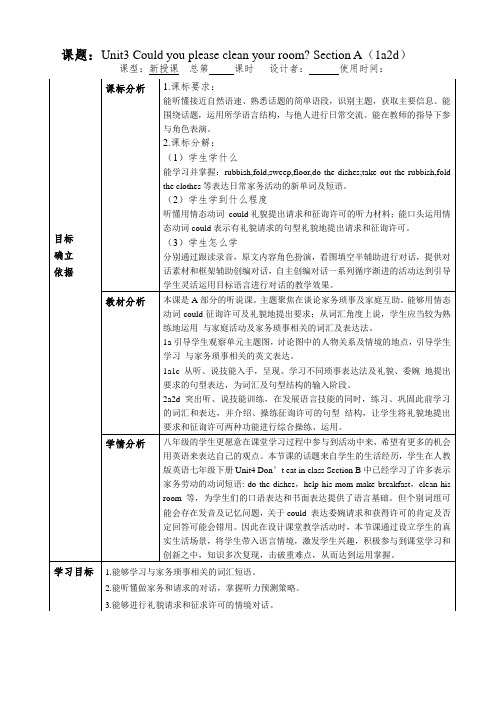
课题:Unit3 Could you please clean your room? Section A(1a2d)课型:新授课总第课时设计者:使用时间:【问题导学】主问题2. .Listening Practice(1)听两遍录音,完成2a~2b中的任务。
(2)利用2a和2b的信息进行对话练习,完成2c。
【学生自学】学生认真听,自主完成教材问题。
【组内互学】1.交流答案及想法,形成统一的意见。
2.利用2a、2b的信息分角色进行对话练习。
【班内展学】以小组为单位进行汇报,邀请23组同学展示。
其他小组认真听,并进行补充和质疑。
【反馈评价】通过听和说的训练,让学生灵活运用“Could I please…?”句型来委婉征求别人的许可, 及回答语“Sure./ Certainly./ Yes,you can .”“Sorry, I have to/am going to do…”。
主问题2预设答案:学习活动三完成教材2d的任务。
【问题导学】主问题3你知道英语中怎样请求得到对方的许可吗?I翻译下列短语。
1. 外出就餐 ________2. 去看电影 ____________________3. 在外呆得晚 _________4. 搭便车_________________5. 从事,忙于 __________6. 需要去做某事_________________7. 不得不去某事 ________ 8. 使用某人的电脑_________________II请和你的搭档操练下列对话12Conversation 1A: Could I use your puter ?B: Sorry, you can’t . I’m going to work on it now .A: Well, could I watch TV?课题:Unit3 Could you please clean your room? SectionA (3a4c)课型:新授课总第课时设计者:使用时间:When and Where did the story happen (发生)?②What did Nancy’s mom request Nancy to do when Nancy just arrived home from school?③Did Nancy agree to do that?④Why wouldn’t Nancy like to take the dog for a walk?⑤Why was Nancy’s mom angry with Nancy? (主干问题)⑥How did Nancy solve the problem at last ?⑦Do you have the same problems as Nancy at home ?⑧How should you solve the problems between you and your parents?在理解阅读材料时,我们首先把文章的______(主干/支干)问题找出来,这个问题就相当于鱼的脊梁。
【精选】人教版八年级下册英语Unit3(第三单元)优秀教案

Unit 3 Could you please clean your room?第一课时Section A (1a2d)【学习目标】1.重点单词:rubbish,fold,sweep,floor,mess2.重点短语:take out the rubbish,fold your clothes,sweep the floor,make your bed,go out for dinner,get a ride3.重点句式:—Could you please sweep the floor?—Yes,sure.—Can I use you computer?—Sorry.I'm going to work on it now.Could you please help out with a few things?Could I at least finish watching this show?I think two hours of TV is enough for you!She won't be happy if she sees this mess.【学习重点】1.重点短语和句型2.熟练运用Could……?提出请求及其回答【学习难点】熟练运用Could……?提出请求及其回答【自主学习】一、预习课本P1718新单词并背诵,完成下面的汉译英。
1.垃圾____________ 2.折叠____________3.打扫____________ 4.地板____________5.杂物____________二、认真预习1a2d找出下列短语和句型。
1.倒垃圾2.叠你的衣服3.扫地4.整理你的床铺5.出去吃饭6.搭车7.—你能扫地吗?—好的,当然可以。
8.—我可以用你的电脑吗?—对不起,我想用它工作。
9.你能帮着做一些事情吗?10.我至少能看完这个节目吗?11.我认为对于你来说两个小时看电视就足够了。
人教版八年级下册英语Unit3(第三单元)优秀教案
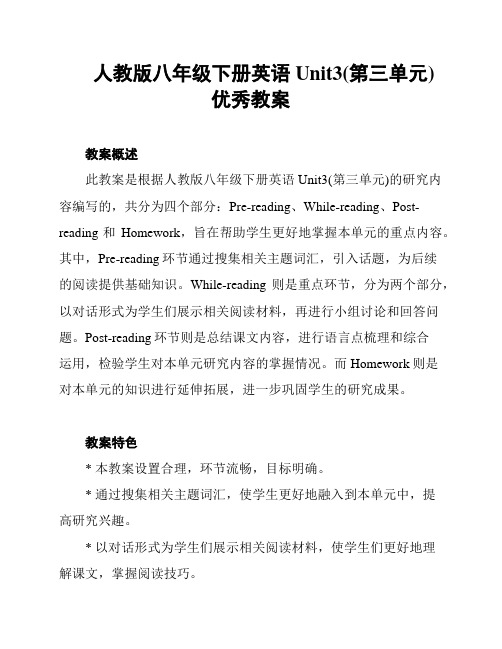
人教版八年级下册英语Unit3(第三单元)优秀教案教案概述此教案是根据人教版八年级下册英语Unit3(第三单元)的研究内容编写的,共分为四个部分:Pre-reading、While-reading、Post-reading和Homework,旨在帮助学生更好地掌握本单元的重点内容。
其中,Pre-reading环节通过搜集相关主题词汇,引入话题,为后续的阅读提供基础知识。
While-reading则是重点环节,分为两个部分,以对话形式为学生们展示相关阅读材料,再进行小组讨论和回答问题。
Post-reading环节则是总结课文内容,进行语言点梳理和综合运用,检验学生对本单元研究内容的掌握情况。
而Homework则是对本单元的知识进行延伸拓展,进一步巩固学生的研究成果。
教案特色* 本教案设置合理,环节流畅,目标明确。
* 通过搜集相关主题词汇,使学生更好地融入到本单元中,提高研究兴趣。
* 以对话形式为学生们展示相关阅读材料,使学生们更好地理解课文,掌握阅读技巧。
* 融入小组讨论和问题回答,激发学生研究积极性和团队合作精神。
* 通过语言点梳理和综合运用,巩固学生对本单元研究内容的掌握情况。
* 设置Homework环节,对本单元的知识进行延伸拓展,进一步巩固学生的研究成果。
教学建议* 教师可以根据本教案的框架,结合自身教学经验和学生的具体情况,进行差异化教学,使教学更具针对性和有效性。
* 教师可以注重激发学生的研究兴趣,设置多样化的教学形式,如PPT、视频等,增强学生对课堂的关注和研究积极性。
* 教师可以加强评价环节,及时反馈学生的表现和问题,并在教学过程中不断进行调整和优化,提高教学效果。
总之,本教案是符合人教版八年级下册英语Unit3(第三单元)学习要求的一份优秀教案,将有力地帮助学生掌握本单元的重点内容,提升学习效果和学习质量。
- 1、下载文档前请自行甄别文档内容的完整性,平台不提供额外的编辑、内容补充、找答案等附加服务。
- 2、"仅部分预览"的文档,不可在线预览部分如存在完整性等问题,可反馈申请退款(可完整预览的文档不适用该条件!)。
- 3、如文档侵犯您的权益,请联系客服反馈,我们会尽快为您处理(人工客服工作时间:9:00-18:30)。
实用标准Unit 3 Could you please clean your room? 教材解读本单元的话题是Chores,主要是关于家庭生活,谈论家务琐事及家庭互助,要求学生学会用Could you please ...?和Could I please ...?来委婉地提出请求或征求别人的许可以及如何有礼貌地拒绝别人并表达自己的理由,陈述自己的好恶。
家庭生活及家务劳动是社会家庭和学生生活中的重要方面,对学生生活习惯的养成、社会行为习惯及家庭责任感的建立起着重要的作用。
通过学习本单元,学生应当能认识到家庭亲情及家庭义务的重要性,应对参加及帮助父母做适当的家务持有积极的态度。
通过单元学习,学生还将了解中西方在这方面的文化差异,增强他们在日常生活中的沟通和交流能力。
单元目标一、知识与技能1. 掌握重点单词和短语。
2. 掌握请求帮助和请求允许及应答的句型:Could you please clean your room? Could I please use the car? Yes,you can. No,you can’t. I have to go out.3. 培养听说读写四项基本技能。
二、过程与方法采用个人独立思考,两人或多人小组合作、交流的学习策略,积极创设较真实的语言环境,利用教学图片、录音机或多媒体课件来展开课堂的听力和口语交际活动。
文档实用标准文档三、情感态度与价值观明确“家务人人有责”的思想,能积极主动地参加家务劳动。
认识到父母照顾家庭的辛劳,养成爱父母、爱家庭、爱家务的好习惯。
学习照顾家庭同时也是照顾自己,培养独立能力,为自己的将来奠定基础。
教法导航采用直观教学法,遵循以学生为主体的原则。
学法导航采用Using contest guessing和Role playing的学习策略,课时支配第1课时:Section A 1a-2d第2课时:Section A 3a-4c第3课时:Section B 1a-2e第4课时:Section B 3a-Self Check课时教案实用标准第1课时Section A 1a-2c教学目标一、知识与技能1. 掌握重点词汇和短语:do the dishes,take out the rubbish,fold your clothes,sweep the floor,make your bed,clean the living room2. 理解并掌握重点句型:Could you please…? Could I …?3. 能听懂有关做家务和日常活动的对话。
二、过程与方法采用情境教学法,调动学生的积极性,引导他们积极参与课堂。
三、情感态度与价值观了解各种家务,能发现要做的家务并积极主动地去做。
教学重点能用本课的重点词汇和句型对家务作出委婉请求。
教学难点能抓住录音中的关键词。
教法导航课上引导学生积极参与课堂活动,老师少讲,鼓励学生多练。
学法导航加强小组合作学习,积极回答问题。
教学准备图片,录音机,多媒体。
教学过程Step 1 GreetingsGreet the students as usual.文档实用标准文档Step 2 Lead-inT:Good morning,boys and girls! I am always very busy on weekends. Somy daughter often helps me with the housework. Do you often help your mother do the chores at home? (Write “chores”on blackboard and explain it.) Here “chore”means housework. Could you please tell me what chores you do at home?S1:I often clean my room.S2:I wash my clothes and fold my clothes.S3:I clean the window.S4:I make my bed and sweep the floor.S5:I clean the living room.T:Well,you are good boys and girls! We should try to be helpful and do some chores at home.Step 3 New words and expressionsAsk the students to look at the picture on Page 17.T:Look at the picture on page 17. What can you see?S1:Peter and his mother.S2:The dustbin is full.S3:The floor is dirty.实用标准文档S4:...T:So there are a lot of chores to do,right? Help students to learn thefollowing phrases about chores:clean the living room; do the dishes; sweep the floor; make the bed; take out the trash; fold the clothesStep 4 PresentationT:If you want to ask somebody to do chores,how can you ask in English?S1:Can you do the chores?S2:Could you please do the chores?T:Which one do you think is better?students:The second one.T:Yes. We should say“Could you please do the chores?”instead of other ways because it sounds very polite. Write “Could you please ...?”on the blackboard.Step 5 Pair workT:In the picture,the mom asks the son to do some chores. What does she say?S:Peter,could you please take out the trash?T:Good! Today,we’ll learn how to make polite requests with could. It is very important to be polite in our life. Now work in pairs. Imagine you are the实用标准mom and the son in the picture. Ask your partner to do the chores that you see.First ask two students to read the sample conversation in activity 1c. Then students make their own conversations. Call several pairs to demonstrate their conversations to the class.Step 6 ListeningT:You will here a conversation between Peter and his mother. What kind of chores do Mom and Peter do? Check Mom or Peter.Play the recording twice. For the first time students focus on the chores Mom does; the second time,focus on the chores Peter does. Then check the answers.Step 7 A little gameFind out the best helper at home.T:Do you often help your parents do the chores? Now let’s choose the best helper at home. First please write down all the chores from your memory on a piece of paper. Then check each chore you do at home. The one who check the most chores will be the best helper at home.Step 8 Group workT:Imagine we are going to clean our classroom this afternoon. You need someone to help you do some things. Think of the things you need to do and文档实用标准make polite requests to your partners. You may find these phrases useful.Show the following phrases on the screen:carry some water,clean the desks,clean the chairs,clean the windows,clean the blackboard,turn off the lights,take down the old pictures,put up the new pictures,sweep the floor. After a few minutes,call several groups to show their conversations.Step 9 PresentationT:I can’t find my pen. But I have to write something now. What can I do?S:You can borrow a pen from others.T:But what should I say?S:Can I use your pen?T:But that doesn’t sound very polite. Any other idea?S:Could I please use your pen? (Write the sentence on the blackboard) T:Good! That’s a very polite way.Step 10 ListeningAsk the students to look at the picture on Page 18. Then say:Look at the picture. That’s Peter and his father. Peter asks his father if he can do four things. Look at the chart in activity 2a. What are the four things? Ask a student to read the things aloud.T:What does his father say? Now please listen to the tape and check ‘yes’文档实用标准or ‘no’in the chart. Play the tape twice. For the first time,they only listen. The second time,they check “yes”or “no”. Then check the answers with the whole class.T:Why Peter’s father say no? What are his reasons? Let’s listen to the conversation again. Draw lines to the reasons in the chart. Before play the tape,ask a student to read the reasons given. Then play the tape. If necessary,play it again. Check the answers.Help students to summarize different ways of answering the question “Could I...?”Yes,you can / I guess so / Oh,yeah / Sure. No,you can’t. ... / Sorry,but ...Step 11 Pair workT:Now look at activity 2c. Work in pairs. Student A is Peter who asks if he can do things. Student B is Peter’s father who says “yes”or “no”. If you say “no”,give a reason.First get two students to read the sample conversation. Then students make their own conversations.Step 12 Group workT:Imagine we’ll have a self-study class this afternoon. You would like to do many different things. How will you ask your teacher for permission? Please do文档实用标准it in groups of four. One will be the teacher,and the others will be the students,make conversation like this:S:Could I please listen to music?T:No you can’t.S:Could I please go to play basketball?T:Sorry,you have to stay in class.S:Could I please draw pictures?T:Yes,you can.After that,get several groups to demonstrate their conversations to the class.Step 13 Homework1. Suppose you are having a party,and you need more drinks and snacks. But you can’t leave the house. Ask your classmates for help. Write a dialogue between you and your classmate with “Could I please ...?”and “Could you please ...?”2. Understand,read and role play the conversation in 2d.课堂作业1. ---Could you please s the floor?---Yes,sure.文档实用标准文档2. ---Could you please do the d ?---Sorry,I can’t. I have to do my homework.3. 我每天早上都整理床铺。
